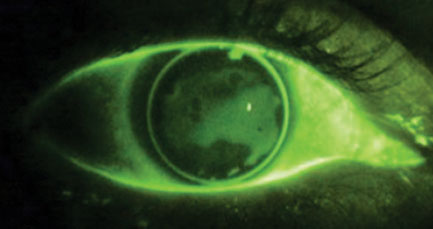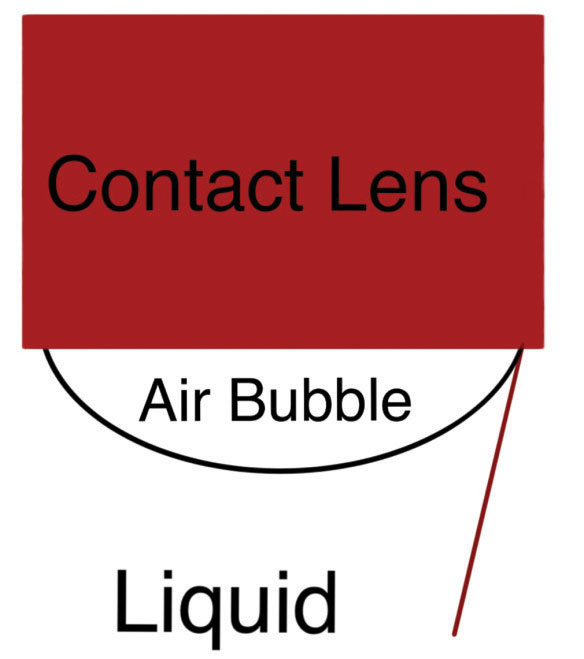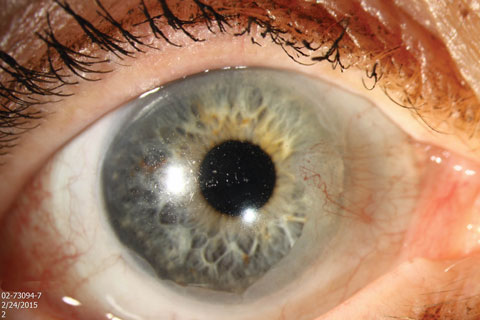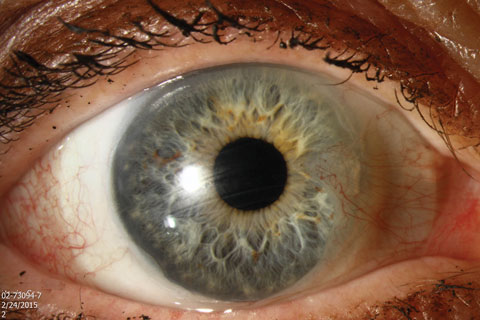42nd Annual Contact Lens ReportFollow the links below to read other articles from annual update on contact lenses: Dissecting the Soft Contact Lens |
Contact lens experts have turned their attention to the contact lens surface and how it contributes to performance. This review of the strengths and limitations of current lens materials can help you better understand why surface treatments may be the next innovation in lens wear.
How it All Started
Contact lenses have come a long way from the days of polymethyl methacrylate acid (PMMA), a predecessor to today’s gas permeable (GP) contact lens materials.
GP lenses. All but obsolete, PMMA contact lenses exhibited excellent optical qualities and lens stability and were resistant to lens deposits. These characteristics allowed for easy manufacturing and long replacement intervals.1 PMMA was also impervious to rigorous wear and care practices and could withstand forceful handling and exposure to off-label cleaning products such as dishwashing liquid. Given the material’s impermeability to oxygen and other gases, successful PMMA lens wear relied on adequate tear exchange to supply oxygen to the eye and remove metabolic byproducts.
 |
| This image depicts poor wetting of a GP lens surface. |
In the late ’70s, silicone was added to create a silicone acrylate (SA) material, a step closer to today’s rigid GP lenses. Materials were then categorized according to oxygen permeability, or “Dk” value. In these early products, Dk increased in proportion to the silicone. The new material came with limitations, however, including significant protein deposition, flexure and parameter instability; they were also easily broken and scratched.
Fluorine was later added to minimize protein deposition, maintain oxygen permeability and improve wettability of the fluorosilicone acrylate (FSA) lens materials that are commonly used today.1 However, these lenses still exhibit more flexure and surface scratches than PMMA.
With earlier generation GP materials, lenses with lower Dk polymers exhibited greater dimensional stability and wettability, which translated to improved vision and comfort.1 Conversely, lenses manufactured with higher Dk materials were less likely to elicit ocular complications associated with hypoxia. Most of today’s products optimize stability and wettability without sacrificing oxygen permeability.
Despite these significant improvements, contact lens deposition and wettability remain problematic, and poor wettability is frequently associated with today’s FSA products. Specific patient populations are more susceptible, as ocular conditions predisposing the patient to poor lens surface wettability include severe dry eye, limbal stem cell deficiency, atopy and corneal exposure from nerve palsy or lagophthalmos.
.jpg) |
| This artist’s conception of contact angles—as measured by the sessile drop technique—shows (from top to bottom) low, medium and high angles. Click image to enlarge. Images by Alyssa Woodruff. |
The resurgence of scleral lenses, with their ability to vault the cornea and create a tear reservoir between the cornea and lens, provides new opportunities as well as challenges. The post-lens tear reservoir continuously bathes the cornea, allowing comfortable wear during waking hours. Patients with irregular corneas who experience lens intolerance or frequent dislocation with corneal lenses can now achieve adequate lens stability and wear time. Sclerals are often a management option for dry eye, particularly when conventional treatments are insufficient.2-4 They are also indicated for the treatment of conditions associated with neuropathic ocular pain.4,5
While the lens-cornea fitting relationship promotes lens stability and limits corneal exposure, some patients may experience severely diminished comfort due to poor contact lens wettability. High Dk lens materials are integral to a successful physiologic response; however, lipid deposition is exacerbated by the properties of high Dk lens material, limited tear exchange and the conditions that predispose the wearer to this lens modality.
Soft contact lenses. In parallel to GP material developments, manufacturers added silicone to conventional hydrogel polymers, creating contemporary silicone hydrogels (SiHy) that were initially developed to eliminate hypoxia in overnight wear.6
Early generation materials were characterized by favorable properties such as exceptionally high oxygen permeability and lower dehydration but less desirable properties such as a higher modulus, hydrophobicity and lipid deposition. As a result, first-generation SiHy lenses rapidly eliminated ocular complications attributed to hypoxia but induced lens-related adverse events ascribed to the mechanical properties of the polymer, such as contact lens papillary conjunctivitis and superior epithelial arcuate lesions.7
Moreover, surface treatments only partially addressed the hydrophobic properties of silicone. Further innovations have yielded contemporary products that optimize the qualities of both silicone and hydrogel polymers, culminating in lenses that are more wettable and biocompatible than their predecessors.
However, both clinical acumen and the literature point to contact lens discomfort as a principal limitation in lens wear. While SiHy lenses are now comparable in comfort to hydrogels, the contact lens dropout rate has remained stable at 15% to 20%.7 Despite improvements in technology, a substantial proportion of lens wearers discontinue contact lens wear, citing symptoms of ocular dryness and lens awareness.8-10
 |
During the captive bubble technique, the investigator places an air bubble on the surface of a contact lens submerged in water and then measures the angle formed between the lens surface and air bubble. Image by Alyssa Woodruff. |
Problems on Top
Contact lens surface properties include: wettability (the ability of a solution to sustain contact with a surface), friction (the force that resists motion between two bodies in contact), lubricity (the capacity for reducing friction—a term describing the “slipperiness” of the material) and deposit resistance (the tendency of protein, lipid and other tear components to adhere to a lens surface).
Surface wettability is presumed to influence the biocompatibility of the lens surface. It may be assessed clinically by observing the interaction between the tears and the contact lens. In vitro wettability can be quantified by measuring the angle between a liquid and a surface. A small angle is attributed to the ability of the tears to spread over the lens, or a hydrophilic lens surface, while a large angle indicates poor wetting, or a hydrophobic lens surface.
Sessile drop, captive bubble and Wilhelmy plate techniques are well-established methods employed to measure contact angles in vitro. In the sessile drop technique, solution is applied to the contact lens surface with a syringe and computer software analyzes the recorded images.
In the captive bubble technique, a contact lens is submerged in water and a syringe is used to place an air bubble on the lens surface. The angle formed between the contact lens surface and air bubble is measured in a similar manner to the sessile drop technique. In the Wilhelmy plate technique, a rectangular sample of the lens material is immersed and removed from the solution. The advancing contact angle is calculated as the sample is inserted in the solution and the receding contact angle is calculated as the lens is removed.11 While laboratory-based measurements are not always indicative of performance on the eye, these methods provide useful measures of lens surface properties.12
Biotribology—the study of friction, lubrication and wear in biological systems—is integral to the understanding of the ocular environment and its interaction with contact lenses. In the application of biotribology to a contact lens on the eye, material scientists have employed the analogy of car hydroplaning: when hydration is plentiful, the ease of the car sliding is independent of the qualities of the car tires. However, when the water dissipates, the frictional behavior changes in response to other environmental characteristics.13 Likewise in contact lens wear, when wettability and lubrication are compromised, vision and comfort are compromised.
Recent studies demonstrate a strong relationship between subjective comfort and lens lubricity, as measured by the coefficient of friction.14-17 As a result, scientists are adapting existing lens materials and creating new lens surfaces to reduce friction and increase surface lubricity.18 Recent work suggests understanding the relationship between lubricity and comfort and developing strategies to improve lubricity may promote contact lens comfort and decrease contact lens dropout.
The Contact Lens-Dry Eye ParadoxContact lens wear is known to disrupt the tear film and triggers symptoms of dryness in previously asymptomatic patients. The Tear Film and Ocular Surface Society’s International Workshop on Contact Lens Discomfort characterized contact lens discomfort (CLD) as “adverse sensations related to lens wear […] resulting from reduced compatibility between the contact lens and the ocular environment.” CLD has been attributed to decreased wearing time and discontinuation of contact lens wear.1 Lens material is one of the parameters influencing the compatibility between the contact lens and the ocular environment. At the same time, scleral contact lenses are an established management option for ocular surface disease.2-4
|
Solutions in the Works
To combat contact lens surface issues, researchers have invented several manufacturing techniques and additional lens surface treatments:
Plasma processing. This is used for both SiHy and GP contact lenses to create a clean, more hydrophilic lens surface that promotes initial lens comfort and reduces fogging. Plasma is sometimes described as a fourth state of matter, as its characteristics differ from those of solids, liquids or gases.19 Plasma is ionized gas consisting of positive ions and free electrons in proportions resulting in, for the most part, no overall electric charge.
GP lenses are exposed to high-energy radio waves in an ionized gas chamber. While laboratories increasingly use water-based, rather than solvent-based, reagents, plasma treatment can further eliminate impurities from the manufacturing process. The process modifies the lens surface but not the basic properties of the lens material. The lens surface becomes ionized, increasing its ability to attract more liquids. The hydrophilic nature of the treated surface impacts the adhesion characteristics, repelling protein, bacteria and other lens contaminants.20
Plasma processing, optional but available on many GPs, has rapidly become routine, if not standard of care.
GP plasma-treated lenses are typically shipped wet in a conditioning solution. Lens care products that contain an abrasive cleaner should not be used on plasma-treated lenses. There are mixed reports regarding the use of alcohol-based cleaners; while such products do not damage the overall lens, the treatment effect may dissipate more rapidly as the surface returns to its original state.
Plasma treatment promotes initial comfort, but the effect decreases over time in GP lenses. While the surface cleaning may be temporary, the altered surface structure may be more permanent and the wettability and inhibition of lens deposits can last for weeks or months.20 In contrast, plasma processing in SiHy lenses is inherent in the lens material; without it these materials would be extremely hydrophobic.
Hydra-PEG (Tangible Science). This coating is intended to improve wettability, increase surface water retention and lubricity, and minimize lens deposits and fogging.21 The coating is a 90% water polyethylene glycol (PEG)-based polymer that has traditionally been used in wound care management.22 The manufacturer describes it as a coating that encapsulates the lens in an ultra-thin polymer, mimicking the mucin-like surface of the cornea.
The lens surface coating can be applied to all contact lens materials including hydrogel, SiHy and GP, including scleral and hybrid lenses. At this time, Contamac, SynergEyes and Bausch + Lomb are global licensing partners that offer Hydra-PEG on some of their products.
 |
 |
| These images depict a soft contact lens before (top) and after (bottom) Hydra-PEG treatment. |
Additional care considerations exist when prescribing lenses with this coating. A coated lens may be more difficult to handle and may require a brief adjustment period for lens application and removal. Approved cleaners include Boston Simplus (Bausch + Lomb), Unique pH (Menicon) and Clear Care Cleaning and Disinfection Solution (Alcon). Buffered, preservative-free sterile saline is the recommended rinsing agent. Enzymatic, abrasive or alcohol-based cleaners should be avoided, as they may damage the coating and reduce its effectiveness. In contrast to plasma treatment, Hydra-PEG enhances wettability across the life of the lens if patients follow the care regimen.
The Future Looks Superficial
Surface treatments on the horizon will likely provide benefits well beyond refractive correction:
Antimicrobial films. Researchers have developed a process to coat lenses with an antimicrobial film to inhibit microbial colonization and biofilm formation with the ultimate goal of reducing the risk of contact lens-related microbial keratitis.23
Wearable electronics. Plasma treatments and Hydra-PEG have been further developed to create lens materials that are both biocompatible and conductive. This could presumably be used in the development of smart contact lens technology, which serves as a platform for wearable technologies that can monitor health status in real time.24
Regenerative technology. Other researchers have developed contact lens surface treatments that can be used as a substrate for the culture of limbal cells responsible for the maintenance and repair of the corneal surface.25 Thus, this surface treatment technology could potentially contribute to the management of limbal stem cell deficiency and aid in other regenerative technologies.
Since their invention, contact lenses have always presented clinicians a challenging balancing act: keeping patients comfortable while also addressing their vision needs. Today’s surface treatments are a significant weapon in the fight against wetting, lens deposition and friction issues—and something clinicians should consider them for patients who present with any of these complaints.
Dr. Wagner is a professor of clinical optometry and director of extern programs at Ohio State University.
| 1. Bennett ES, Henry VA, eds. Clinical manual of contact lenses. 4th ed. Philadelphia: Liippincott Williams & Wilkins; 2013. 2. Bavinger JC, DeLoss K, Mian SI. Scleral lens use in dry eye syndrome. Curr Opin Ophthalmol. 2015;26(4):319-24. 3. Jones L, Downie LE, Korb D, et al. TFOS DEWS II management and therapy report. Ocul Surf. 2017;15(3):575-628. 4. Jacobs DS, Rosenthal P. Boston scleral lens prosthetic device for treatment of severe dry eye in chronic graft-versus-host disease. Cornea. 2007;26(10):1195-9. 5. Rosenthal P, Borsook D. Ocular neuropathic pain. Br J Ophthalmol. 2016;100(1):128-34. 6. Guillon M. Are silicone hydrogel contact lenses more comfortable than hydrogel contact lenses. Eye Contact Lens. 2013;39(1):86-92. 7. Dumbleton K. Adverse events with silicone hydrogel continuous wear. Cont Lens Anterior Eye. 2002;25(3):137-46. 8. Dumbleton K, Woods CA, Jones LW, Fonn D. The impact of contemporary contact lenses on contact lens discontinuation. Eye Contact Lens. 2013;39(1):93-9. 9. Dumbleton K, Caffery B, Dogru M, et al. The TFOS international workshop on contact lens discomfort: report of the subcommittee on epidemiology. Invest Ophthalmol Vis Sci. 2013;18:TFOS20-36. 10. Richdale K, Sinnot LT, Skadahl E, Nichols JJ. Frequency of and factors associated with contact lens dissatisfaction and discontinuation. Cornea. 2007;26(2):168-74. 11. Campbell D, Carnell SM, Eden RJ. Applicability of contact angle techniques used in the analysis of contact lenses, part 1: comparative methodologies. Eye Contact Lens. 2013;39(3):254-62. 12. Menzies KL, Jones L. The impact of contact angle on the biocompatibility of biomaterials. Optom Vis Sci. 2010;87(6):387-99. 13. Mann A, Tighe BJ. Ocular biotribology and the contact lens: surface interactions and ocular response. In: Chirila T, Harkin D, eds. Biomaterials and regenerative medicine in ophthalmology. 2nd ed. Cambridge, MA: Woodhead Publishing; 2016. 14. Coles C, Brennan NA. Coefficient of friction and soft contact lens comfort. Optom Vis Sci. 2012;89:125603. 15. Kern J, Rappon J, Bauman E, Vaughn B. Relationship between contact lens coefficient of friction and subjective lens comfort. IOVS. 2013;54:494. 16. Vidal-rohr M, Wolffsohh JS, Davies LN, Cerviño A. Effect of contact lens surface properties on comfort, tear stability and ocular physiology. Cont Lens Anterior Eye. 2018;41(1):117-21. 17. Singh A, Corvelli M, Unterman SA, et al. Enhanced lubrication on tissue and biomaterial surfaces through peptide-mediated binding of hyaluronic acid. Nat Mater. 2014;13(10):988-95. 18. Stapleton F, Tan J. Impact of contact lens material, design, and fitting on discomfort. Eye Contact Lens. 2017;43:32-9. 19. Plasma Treatment of Contact Lenses and Optics. Henniker Plasma. https://plasmatreatment.co.uk/industries/plasma-treatment-contact-lenses-optics. Accessed July 10, 2018. 20. Wang Y, Qian X, Zhang X, et al. Plasma surface modification of rigid contact lenses decreases bacterial adhesion. Eye Contact Lens. 2013;39(6):376-80. 21. Sindt CW. Tangible Hydra-PEG: A novel custom contact lens coating technology designed to improve patient comfort and satisfaction. Tangible Hydra-PEG. 2016. https://docs.wixstatic.com/ugd/dd2daf_6d730c1482f6450396c734d74c3017b6.pdf. Accessed July 10, 2018. 22. Chen SL, Fu RH , Liao SF, et al. A PEG-based hydrogel for effective wound care management. Cell Transplant. 2018;27(2):275-84. 23. Cheng W, Yang C, Ding X, et al. Broad-spectrum antimicrobial/antifouling soft material coatings using poly(ethylenimine) as a tailorable scaffold. Biomacromolecules. 2015;16(7):1967-77. 24. Moser T, Celma C, Lebert A, et al. Hydrophilic organic electrodes on flexible hydrogels. ACS Applied Materials & Interfaces 2016;8(1):974-82. 25. Zhang H, Brown KD, Lowe SP, et al. Acrylic acid surface-modified contact lens for the culture of limbal stem cells. Tissue Eng. 2014;20(11-12):1593-1602. |

